Ernst Josephson: Konst, Poesi & Musik (Ernst Josephson: Art, Poetry and Music)
Reviewed by David SmithDavid Smith
University of Oxford
Email the author: david.smith[at]pharm.ox.ac.uk
Citation: David Smith, exhibition review of Ernst Josephson: Konst, Poesi & Musik (Ernst Josephson: Art, Poetry and Music), Nineteenth-Century Art Worldwide 23, no. 2 (Autumn 2024), https://doi.org/10.29411/ncaw.2024.23.2.23.
This work is licensed under a Creative Commons Attribution-NonCommercial 4.0 International License  unless otherwise noted.
unless otherwise noted.
Your browser will either open the file, download it to a folder, or display a dialog with options.
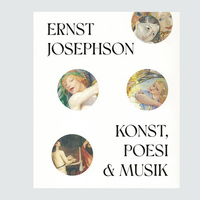
Ernst Josephson: Art, Poetry and Music
Prins Eugens Waldemarsudde, Stockholm
September 9, 2023–February 11, 2024
Catalogue:
Karin Sidén, Birte Bruchmüller, Catrin Lundeberg, eds.,
Ernst Josephson: Konst, Poesi & Musik.
Stockholm: Prins Eugens Waldemarsudde, 2023.
251 pp.; 136 color illus.; essays; chronology.
184 SEK
ISBN: 9789186265632
Art in the Nordic countries was flourishing in the late nineteenth century, and one of its leading protagonists was the Swede Ernst Josephson (1851–1906). Ernst Josephson: Art, Poetry and Music is the first major exhibition of Josephson’s work in more than twenty years, and it is an opportunity to appreciate the breadth and depth of his contributions. As the title indicates, Josephson was not only a painter; he also wrote poetry and composed music. Some of his recorded piano music could be heard in one of the rooms in the exhibition. His poetry was much appreciated at the time, and the composer Jean Sibelius set several of his poems for piano and voice. A group of eight poems were set as “Opus 57,” which is one of the composer’s finest works in this format. The rest of this review will focus on Josephson’s paintings. The exhibition has more than a hundred items—arranged thematically—and occupies five rooms with insightful explanatory texts in English as well as Swedish. The beautifully illustrated accompanying book serves not only as a catalogue but also contains several scholarly articles based on recent research and reproductions of several of the artist’s works that are not included in the exhibition. The catalogue is in Swedish but has a six-page summary in English. The articles (in Swedish) are as follows: Karin Sidén’s “Tradition and Renewal,” Hans Henrik Brummer’s “Strömkarlen” (“The Water-Sprite”), Charlotta Nordström’s “Artistic Profile,” Anders Cullhed’s “On Ernst Josephson’s Poetry,” Anders Hammarlund’s “Ernst Josephson the Musician,” and Birte Bruchmüller’s “Ecstatic Bodies and Spiritual Visions.”
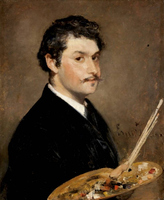

Josephson, who grew up in a Jewish family with wide cultural interests, was raised in Stockholm. At 16, he attended the preparatory school of the Royal Academy of Fine Arts, where he stayed for nine years. Then, at the age of 23, he was accepted as a student of Jean-Léon Gérôme in Paris. His skill at that time is shown from a self-portrait he painted when he was 24 (fig. 1). During this period, he travelled often to study works from several European artists, focusing on Rembrandt, Raphael, and Velázquez. The exhibition included a remarkably fine copy of Rembrandt’s Syndics of the Drapers Guild (1876–77; National Museum, Stockholm) that he made when he was 26. The accompanying text quotes the artist Richard Bergh (1893): “Many have copied Rembrandt’s Syndics; in doing so, no one compares to Ernst Josephson who into this work has placed his entire soul, his entire burning love for everything strong, everything deep, everything flourishing, everything glowing with blood-filled ambience” (26).
Josephson became a member of the Swedish artists contingent in Paris in the 1880s, and he was a leader of the group known as the Opponents, who campaigned against the policies of the Swedish Royal Academy. Influenced by the French style of painting, he became an outstanding portraitist, and the exhibition had some superb examples, notably those of his mother and one of Pontus Fürstenberg, a key art promotor in Gothenburg (fig. 2).
Several genre paintings stand out in the exhibition, including the relatively early Spanish Blacksmiths (fig. 3) with its fine depictions of two blacksmiths and an old woman. A painting of a street scene in France, The Fourteenth of July (fig. 4), also has several well-characterized figures. The room with these and related paintings provided an uplifting experience.
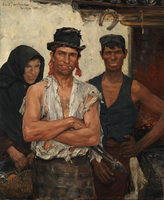
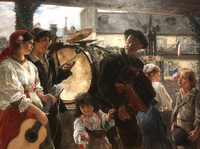
Josephson became interested in spiritual matters quite early in his career and participated in séances, as perceptively described in Bruchmüller’s essay. Both spiritual and esoteric themes (accessing and decoding higher truths) can be found in several paintings, notably in his most well-known work, Strömkarlen—or, The Water-Sprite (fig. 5)—which has hung permanently in the former home of Prins Eugen since 1905 (fig. 6), adjacent to where the exhibition was held. The exhibition also shows two earlier versions of this work (fig. 7), and it is fascinating to follow the evolution of the artist’s ideas, as described in Hans Henrik Brummer’s essay. The explanatory text vividly described this work:
The body language and facial expressions of the water-sprite while he plays his music demonstrate ecstatic rapture. The fiddle’s sounds, along with the gushing of the rapids in the background, together form an auditory image that contributes to moving the water-sprite into a state of heightened consciousness. (160)
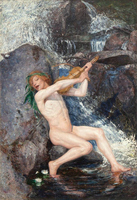
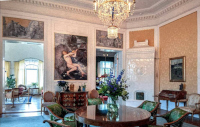
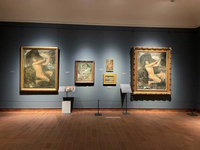
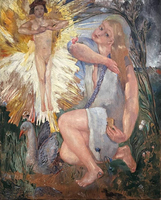
Josephson suffered psychotic episodes later in his life and spent time in a hospital. After that, most of his artistic works were drawings, several of which were on display. A few striking paintings from this period were also exhibited, notably The Goose Girl (fig. 8), which, as Bruchmüller discusses, has strong spiritual overtones (51).
Overall, the exhibition gave a rounded and moving account of the work of this artist who combined masterly technique with sensitivity to human character and awareness of the spiritual domain. He should be better known outside Scandinavia.